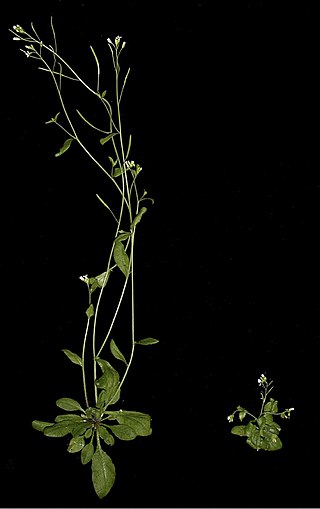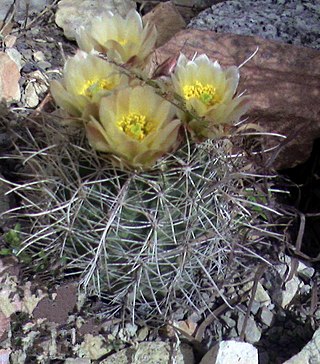Scarification in botany involves weakening, opening, or otherwise altering the coat of a seed to encourage germination. Scarification is often done mechanically, thermally, and chemically. The seeds of many plant species are often impervious to water and gases, thus preventing or delaying germination. Any process designed to make the testa (seed coat) more permeable to water and gases is known as scarification.
Scarification, regardless of type, works by speeding up the natural processes which normally make seed coats permeable to water and air. For drupes (stone fruits), scarification also extends to weakening or removal of the hard endocarp shell around the seed.
Regardless of the method, scarified seeds do not store well and need to be planted quickly, lest the seeds become unviable.
The most common type of scarification is mechanical scarification.
In mechanical scarification, the testa is physically opened to allow moisture and air in. [1] Seed coats may be filed with a metal file, rubbed with sandpaper, nicked with a knife, cracked gently with a hammer, or weakened or opened in any other way.
The imbibition of water through seed shell membrane is affected by water temperature. Species that can withstand hot water will sprout faster under that condition than from cold tap water.
The North Carolina State University recommends placing the seeds in boiling water and letting them soak while the water cools to room temperature, and then remove the seeds from the water and sow. [2] The buoyancy of floating seeds must be compensated with gravity to submerge them, this can be achieved with an infuser.
Hot water scarification can be combined with chemical scarification, but might require protective equipment against formed gases.
Hot water treatment is also used for removal of pathogens. Placing seeds in 90 °C for 90 seconds followed by dip in cold water for 30 seconds kills the human pathogens Escherichia coli O157:H7 and Salmonella . [3] A variety of plant pathogens are also killed by hot water treatment. [4]
In some chaparral plant communities, some species' seeds require fire and/or smoke to achieve germination. An exception to that phenomenon is western poison oak, whose thick seed coatings provide a time delayed effect for germination, but do not require fire scarification. [5]
Chemical scarification occurs commonly in nature in the course of endozoochory—when animals consume fruits and seeds and their stomach acids soften and begin to break down testae, rendering them more permeable to water. After the seeds have been expelled through defecation they are not only pre-packaged in plant nutrient-rich faeces but also more susceptible to imbibition—the process of water uptake essential to the initiation of germination. [6]
Artificial scarification involves human use of one or more chemicals to mimic the natural stomach acids of frugivorous animals to promote germination. [6] It can involve soaking seeds in precisely concentrated acidic or basic solutions for varying amounts of time. Chemicals such as sulfuric acid or even household chemicals can be used to affect this process. Chemical scarification can also be achieved through the use of nutrient salts such as potassium nitrate.
Common chemicals that don't require special permission in solution form:
Pure forms of the chemicals listed above is unnecessary and often require special permission to obtain.
Because scarified seeds tend to germinate more often and in less time than unaltered seeds, scarification finds use not just in industry but on the small scale. In home gardens, for example, the seeds of plants which are otherwise difficult to grow from seed may be made viable through scarification. The thawing and freezing of water, fire and smoke and chemical reactions in nature are what allow seeds to germinate but the process can be sped up by using the various methods described thus far. The common objective is opening the testa to allow air and water into the seed. In horticulture, scarification is often used to facilitate the controlled and uniform germination of seed lots.
A paper was published in the New Zealand Journal of Experimental Agriculture in which the authors stated that the seeds they examined in their study germinated only 30% under the preferred conditions, yet when they were treated chemically with concentrated sulphuric acid or mechanically scarified, the germination rate increased to more than 80%. [7]
Another study was done on four different types of Great Basin lupine species to see the effect different methods of scarification would have on said seeds. The longspur lupine, silvery lupine, hairy bigleaf lupin, and silky lupine were the four species experimented on throughout the study. Species exhibited differential responses to scarification. The Silky lupine's highest germination rate was achieved via mechanical scarification at 66.4%, opposed to its 22% germination rate found in the control group. Using thermal and chemical scarification, germination increased to 48.8% and 44% respectively. 68% of Longspur lupine seeds germinated in the control group, while all scarification methods decreased the success rate of germination. The silvery lupine had 52% of its control group germinate but through mechanical scarification it rose to 85.2%. Finally the hairy bigleaf lupine's control group germination rate was 32% yet when treated with sulfuric acid it rose to 76.8%. [10]

In botany, a seed is a plant embryo and food reserve enclosed in a protective outer covering called a seed coat (testa). More generally, the term "seed" means anything that can be sown, which may include seed and husk or tuber. Seeds are the product of the ripened ovule, after the embryo sac is fertilized by sperm from pollen, forming a zygote. The embryo within a seed develops from the zygote and grows within the mother plant to a certain size before growth is halted.

Sowing is the process of planting seeds. An area that has had seeds planted in it will be described as a sowed or sown area. When sowing it is important to:

The chickpea or chick pea is an annual legume of the family Fabaceae, subfamily Faboideae. Its different types are variously known as gram or Bengal gram, chhola, chhana, chana, or channa, garbanzo or garbanzo bean, or Egyptian pea. Chickpea seeds are high in protein. It is one of the earliest cultivated legumes, the oldest archaeological evidence of which was found in Syria.
Hygroscopy is the phenomenon of attracting and holding water molecules via either absorption or adsorption from the surrounding environment, which is usually at normal or room temperature. If water molecules become suspended among the substance's molecules, adsorbing substances can become physically changed, e.g. changing in volume, boiling point, viscosity or some other physical characteristic or property of the substance. For example, a finely dispersed hygroscopic powder, such as a salt, may become clumpy over time due to collection of moisture from the surrounding environment.

Germination is the process by which an organism grows from a seed or spore. The term is applied to the sprouting of a seedling from a seed of an angiosperm or gymnosperm, the growth of a sporeling from a spore, such as the spores of fungi, ferns, bacteria, and the growth of the pollen tube from the pollen grain of a seed plant.

Dormancy is a period in an organism's life cycle when growth, development, and physical activity are temporarily stopped. This minimizes metabolic activity and therefore helps an organism to conserve energy. Dormancy tends to be closely associated with environmental conditions. Organisms can synchronize entry to a dormant phase with their environment through predictive or consequential means. Predictive dormancy occurs when an organism enters a dormant phase before the onset of adverse conditions. For example, photoperiod and decreasing temperature are used by many plants to predict the onset of winter. Consequential dormancy occurs when organisms enter a dormant phase after adverse conditions have arisen. This is commonly found in areas with an unpredictable climate. While very sudden changes in conditions may lead to a high mortality rate among animals relying on consequential dormancy, its use can be advantageous, as organisms remain active longer and are therefore able to make greater use of available resources.

Plant hormones are signal molecules, produced within plants, that occur in extremely low concentrations. Plant hormones control all aspects of plant growth and development, including embryogenesis, the regulation of organ size, pathogen defense, stress tolerance and reproductive development. Unlike in animals each plant cell is capable of producing hormones. Went and Thimann coined the term "phytohormone" and used it in the title of their 1937 book.

Sprouting is the natural process by which seeds or spores germinate and put out shoots, and already established plants produce new leaves or buds, or other structures experience further growth.

A tea infuser is a device in which loose, dried tea leaves are placed for steeping or brewing, in a mug or a teapot full of hot water; it is often called a teaball or tea maker, and sometimes a tea egg. The tea infuser gained popularity in the first half of the 19th century. Tea infusers enable one to easily steep tea from fannings and broken leaf teas.
Silviculture is the practice of controlling the growth, composition/structure, as well as quality of forests to meet values and needs, specifically timber production.

Sclerocactus is a genus of cacti. It comprises about 15 species, the exact number depending on the authority. These species are xerophytic. They are sometimes called 'fishhook cactus' or 'little barrels.'
Seed dormancy is an evolutionary adaptation that prevents seeds from germinating during unsuitable ecological conditions that would typically lead to a low probability of seedling survival. Dormant seeds do not germinate in a specified period of time under a combination of environmental factors that are normally conducive to the germination of non-dormant seeds.

Erythrina mulungu (Mulungu) is a Brazilian ornamental tree and medicinal plant native to the cerrado and caatinga ecoregions in Brazil, South America.

Lupinus texensis, the Texas bluebonnet or Texas lupine is a species of lupine found in Texas, Louisiana, Arkansas and the Mexican states of Coahuila, Nuevo León, and Tamaulipas. With other related species of lupines also called bluebonnets, it is the state flower of Texas.

Lupinus albus, commonly known as the white lupin or field lupine, is a member of the genus Lupinus in the family Fabaceae. It is a traditional pulse cultivated in the Mediterranean region.

Tylosema esculentum, with common names gemsbok bean and marama bean or morama bean, is a long-lived perennial legume native to arid areas of southern Africa. Stems grow at least 3 metres (9.8 ft), in a prostrate or trailing form, with forked tendrils that facilitate climbing. A raceme up to 25 millimetres (1 in) long, containing many yellow-orange flowers, ultimately produces an ovate to circular pod, with large brownish-black seeds.

Lupinus perennis is a flowering plant in the family Fabaceae.
Pythium aphanidermatum is a soil borne plant pathogen. Pythium is a genus in the class Oomycetes, which are also known as water molds. Oomycetes are not true fungi, as their cell walls are made of cellulose instead of chitin, they are diploid in their vegetative state, and they form coenocytic hyphae. Also, they reproduce asexually with motile biflagelette zoospores that require water to move towards and infect a host. Sexually, they reproduce with structures called antheridia, oogonia, and oospores.

Anisodus tanguticus is a species of flowering plant belonging to tribe Hyoscyameae of subfamily Solanoideae of the nightshade family Solanaceae. It is thus closely related to Henbane and Deadly Nightshade. Solanaceae is a plant family which includes many important agricultural plants such as the potato and the tomato. It is mostly found growing in the Qinghai-Tibetan Plateau. A. tanguticus is collected and used mostly for its medicinal effects caused by the plant's biologically active nicotine and tropane alkaloids. It has a significant impact in China as one of the 50 fundamental herbs used in traditional Chinese medicine.
In horticulture, stratification is a process of treating seeds to simulate natural conditions that the seeds must experience before germination can occur. Many seed species have an embryonic dormancy phase and generally will not sprout until this dormancy is broken.